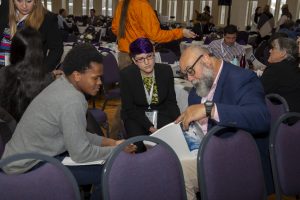
University role in relief: Reflections on new roles in disaster response
By Alex Halloway (UNC-CH Master of City and Regional Planning Candidate, 2020)
Over the course of the conference I found myself gravitating towards the panels that focus on the role that universities can play in disaster planning and recovery. One of these panels was called “University Role in Relief: Reflections on the Universities New Roles in Disaster Response.” This panel had representatives from Texas A&M University, Arizona State University, University of Puerto Rico at Mayagüez, Tufts University and the University at Albany. The panel was moderated by Ethel Marie Ríos Orlandi from the University of Puerto Rico, Rio Piedras campus.
There were two speakers in particular that stuck out to me during this panel. The first was Cory Arcak from the Jordan Institute for International Awareness at Texas A&M. She spoke to the audience about her experience setting up a student service-learning project that assisted with the post- María efforts in the summer of 2018. Arcak began by sharing a video that featured student testimonials about the project, in which many spoke about how being a part of the project better taught them how to assist affected communities while recognizing that the community members themselves are the ones that should “be in the driver’s seat.” As one student said, being a part of the project meant learning to “to be a servant and not just a helper.” Not only this, but many of the students recognized that the community members were not just looking for service but for a chance to tell their stories so that their situations and lives could better be known. Arcak also spoke about some of the practical steps she had to use to leverage support from her university for the project. This later led to a discussion during the Q&A session about how post-disaster planning should not just be focused solely on the built environment, but also on economic development in order to empower the effected members of the community.
The second speaker that stuck out to me was Angélica Valdés Valderrama, a doctoral student in Food Nutrition and Policy at Tufts University (one of two doctoral students on the panel). She spoke on her community activism experience after María with the organization Brigada Solidaria del Oeste. For her, the experience of returning to her homeland to assist with recovery efforts helped her to recognize the privileges she had during that process. It also helped her recognize five areas of post-disaster planning that should be prioritized: Infrastructure, vulnerable groups, mental health, equality and responsible research.
___________________________________________________
News from Coastal Resilience Blog
News and perspectives from the DHS Coastal Resilience Center of Excellence at UNC-Chapel Hill
Learn more:
Coastal Resilience Center
The mission of the Coastal Resilience Center of Excellence (CRC) is to conduct research and education to enhance the resilience of the nation’s people, infrastructure, economies and the natural environment to the impacts of coastal hazards such as floods and hurricanes, including the effects of future trends.
The University of North Carolina at Chapel Hill leads the CRC, made possible through a five-year, $20 million grant from the Department of Homeland Security (DHS) Science and Technology Directorate, Office of University Programs. The CRC is a consortium of universities, private companies, and government agencies focused on applied research, education and outreach addressing threats to coastal communities due to natural hazards.
The CRC expands on work conducted through the DHS Coastal Hazards Center of Excellence, which was co-led by UNC-Chapel Hill and Jackson State University from 2008 to 2015. Successful outcomes of research supported by the Coastal Hazards Center can be found at hazardscenter.unc.edu.